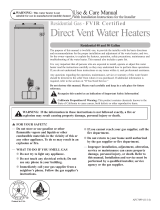
Internet Version for Reference Only
Installation (Venting) continued-
Canadian
Installations
1
US Installations
2
F= Clearance to outside corner *b *b
G= Clearance to inside corner *b *b
H= Clearance to each side of center line
extended above meter/regulator
assembly
3 feet (91 cm)
within a height
15 feet (4.6 m)
above the
meter/regulator
assembly
*b
I= Clearance to service regulator vent
outlet or oil tank vent
36 inches
(91 cm)
*b
J= Clearance to non-mechanical air
supply inlet to building or the
combustion air inlet to any other
appliance
12 inches (30
cm)
9 inches (23 cm) for appliances
> 10,000 Btuh (3 kW) and ≤
50,000 Btuh (15 kW), 12 inches
(30 cm) for appliances > 50,000
Btuh (15 kW)
K= Clearance to a mechanical air supply
inlet
6 feet
(1.83 m)
3 feet (91 cm) above if within 10
feet horizontally
L= Clearance above paved sidewalk or
paved driveway located on public
property
7 feet
(2.13 m)†
*b
M= Clearance under a veranda, porch,
deck, or balcony
12 inches (30
cm) ‡
*b
1
In accordance with the current CAN/CGA-B149 Installation Codes.
2
In accordance with the current ANSI Z223.1-(Latest edition)/NFPA 54 National Fuel Gas Code.
† A vent shall not terminate directly above a sidewalk or paved driveway that is located between
two single-family dwellings and serves both dwellings.
‡ Permitted only if a veranda, porch, deck or balcony is fully open on a minimum of two sides beneath
the floor.
*a) A minimum clearance value determined by testing in accordance with section 2.20.
*b) “Clearance in accordance with local installation codes and the requirements of the gas supplier”.
The vent system must terminate so that proper clearances are maintained
as cited in local codes or the latest edition of the National Fuel Gas Code,
ANSI Z223.1.73.4e and 7.8a, b as follows:
1. Do not terminate near soffit vents or crawl space or other area where
condensate or vapor could create a nuisance or hazard or cause
property damage.
2. Do not terminate the exhaust vent terminal where condensate or vapor
could cause damage or could be detrimental to the operation of
regulators, relief valves, or other equipment.
3. Do not terminate the exhaust vent terminal over public area or walkways
where condensate or vapor can cause nuisance or hazard.
4. The vent shall terminate a minimum of 12 inches above expected
snowfall level to prevent blockage of vent termination.
Vent pipes serving power vented appliances are classified by building codes
as “vent connectors”. Required clearances from combustible materials must
be provided in accordance with information in this manual under LOCATION
OF WATER HEATER and CLEARANCES, and with National Fuel Gas Code
and local codes.
13




















